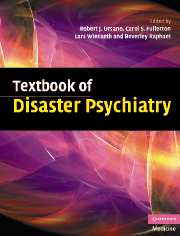Book contents
- Frontmatter
- Contents
- List of contributors
- Preface
- Part I Introduction
- Part II Foundations of disaster psychiatry
- Part III Clinical care and interventions
- Part IV Special topics
- 11 Traumatic death in terrorism and disasters
- 12 Weapons of mass destruction and pandemics: global disasters with mass destruction and mass disruption
- 13 Workplace disaster preparedness and response
- 14 Healthcare systems planning
- Part V Public health and disaster psychiatry
- Index
- References
13 - Workplace disaster preparedness and response
from Part IV - Special topics
Published online by Cambridge University Press: 09 August 2009
- Frontmatter
- Contents
- List of contributors
- Preface
- Part I Introduction
- Part II Foundations of disaster psychiatry
- Part III Clinical care and interventions
- Part IV Special topics
- 11 Traumatic death in terrorism and disasters
- 12 Weapons of mass destruction and pandemics: global disasters with mass destruction and mass disruption
- 13 Workplace disaster preparedness and response
- 14 Healthcare systems planning
- Part V Public health and disaster psychiatry
- Index
- References
Summary
Introduction
In the United States and countries throughout the world, natural and human-made disasters have affected the workplace, resulting in extensive psychological, behavioral, and health consequences for workers, families, and communities (Ursano et al., 2006). Natural disasters such as the Kobe earthquake, the Asian Tsunami, and Hurricane Katrina destroyed businesses, large and small, and disrupted the livelihood, health, and social supports of large populations. Human made disasters resulting in similar consequences range from industrial accidents, the worst occurring in 1984 in Bhopal, India, claiming some 20 000 lives due to lethal gas exposure (Dhara & Dhara, 2002), to violent acts of disgruntled employees, to the effects of terrorism and bioterrorism. In some instances, the workplace has been the intentional target of traumatic events, such as the US Kenya embassy bombing, the Oklahoma City bombing, the events of September 11 and the anthrax attacks on the United States Postal Service (Stith Butler et al., 2003; Ursano et al., 2003; Vineburgh et al., 2005a, 2005b, 2005c). Disasters also affect people on their way to work, as happened in the subway sarin gas attacks in Tokyo and the transportation terror bombings in Madrid (Miguel-Tobal et al., 2006) and London (Rubin et al., 2005).
Work is a central organizing factor in most lives, providing economic survival, a sense of identity, social connectedness, and purpose (Levinson, 1965; McLean, 1973).
Keywords
- Type
- Chapter
- Information
- Textbook of Disaster Psychiatry , pp. 265 - 283Publisher: Cambridge University PressPrint publication year: 2007



